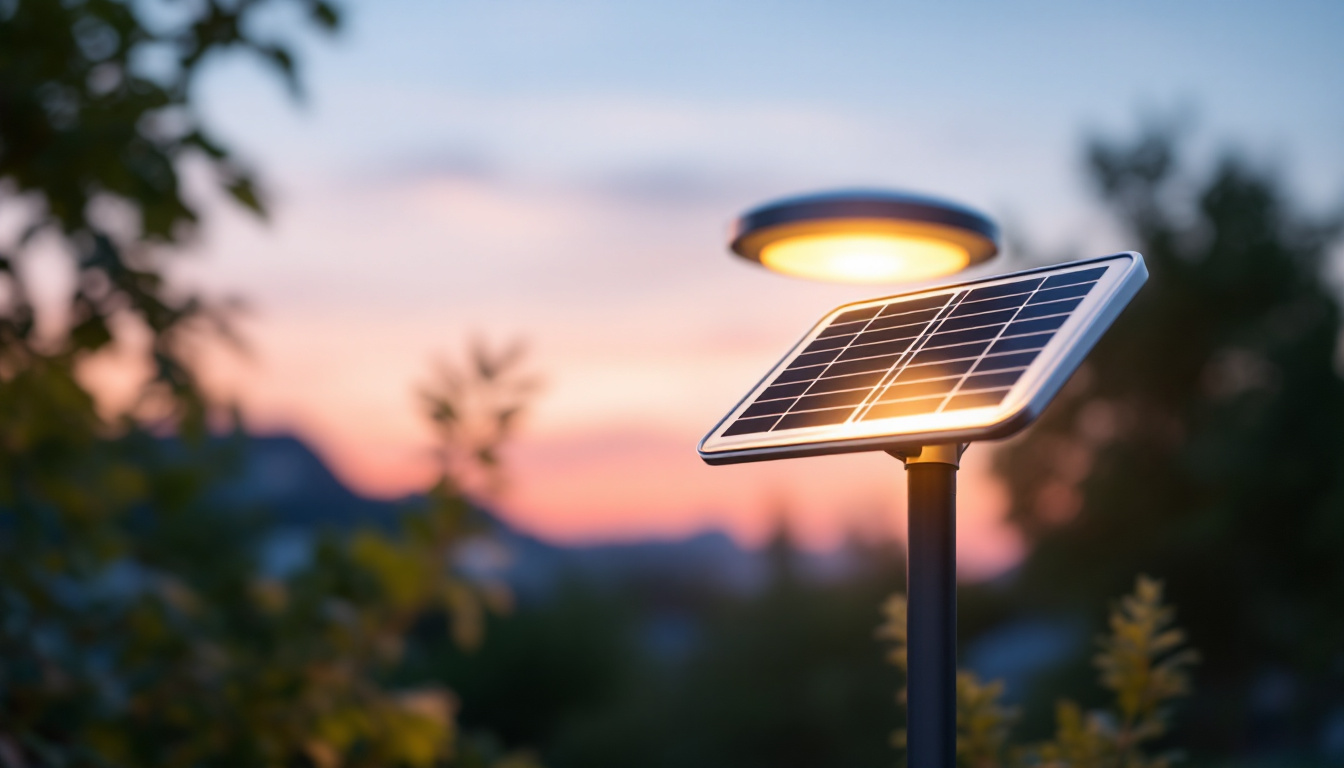
In recent years, the demand for sustainable energy solutions has surged, prompting many industries to explore innovative technologies. One such advancement is the integration of solar panels into lighting installations. This approach not only reduces energy costs but also enhances the appeal of outdoor and indoor spaces. For lighting contractors, understanding the benefits and profitability of solar panel integration is crucial for staying competitive in a rapidly evolving market.
solar-powered lamps utilize photovoltaic technology to convert sunlight into electricity, providing a renewable energy source for lighting. This shift towards solar energy offers numerous advantages, including reduced operational costs, lower carbon footprints, and increased energy independence. As the industry embraces these eco-friendly solutions, contractors must adapt their strategies to maximize profitability while meeting the growing demand for sustainable lighting options.
Moreover, the versatility of solar-powered lighting solutions makes them suitable for a wide range of applications, from residential gardens to commercial parking lots. These systems can be designed to blend seamlessly with their surroundings, offering aesthetic appeal while serving practical purposes. For instance, solar pathway lights not only illuminate walkways but also enhance safety and security, making them an attractive option for homeowners and businesses alike. Additionally, advancements in battery storage technology have allowed for longer-lasting solutions, enabling lights to operate efficiently even during cloudy days or at night.
Another significant aspect of solar-powered lighting is its potential to contribute to energy resilience in communities. By decentralizing energy production, solar lights can provide reliable illumination in areas prone to power outages or in remote locations where traditional electrical infrastructure is lacking. This capability not only supports public safety but also fosters a sense of community empowerment, as neighborhoods can take charge of their energy needs. As awareness of these benefits grows, so too does the opportunity for contractors to educate clients on the long-term advantages of investing in solar lighting solutions, ultimately leading to a more sustainable future for all.
Integrating solar panels into lighting installations brings a wealth of benefits that can enhance both project appeal and profitability. These advantages extend beyond mere cost savings, impacting the overall value proposition for clients.
One of the most compelling reasons to incorporate solar panels into lighting systems is the potential for significant cost savings. By harnessing solar energy, contractors can reduce or eliminate electricity bills associated with traditional lighting solutions. This is particularly beneficial in areas where electricity rates are high or where grid access is limited.
Moreover, solar-powered lamps often require less maintenance than conventional lighting systems. With fewer components that can fail and no reliance on external power sources, the long-term operational costs are reduced. This efficiency not only appeals to budget-conscious clients but also enhances the contractor’s reputation for delivering cost-effective solutions.
As sustainability becomes a primary concern for businesses and consumers alike, the environmental benefits of solar-powered lighting cannot be overstated. By utilizing renewable energy, contractors contribute to reducing greenhouse gas emissions and reliance on fossil fuels. This commitment to sustainability can be a powerful selling point when pitching projects to eco-conscious clients.
Additionally, many municipalities and organizations are increasingly prioritizing green initiatives, often providing incentives for solar installations. These incentives can include tax breaks, grants, or rebates, further enhancing the financial viability of solar-powered lighting projects.
Solar-powered lamps come in a variety of designs and styles, allowing contractors to offer aesthetically pleasing solutions that complement any environment. From garden pathways to urban streetscapes, solar lighting can enhance the visual appeal of spaces while providing functional illumination.
Furthermore, the absence of wiring and the flexibility of placement mean that solar lamps can be installed in locations that traditional lighting cannot reach. This versatility allows contractors to meet diverse client needs and create unique lighting installations that stand out in the market.
When considering solar panel integration for lighting installations, selecting the appropriate system is paramount. Various factors influence the choice of solar panels, including energy requirements, location, and budget constraints.
Before selecting a solar panel system, it is essential to conduct a thorough assessment of the energy needs for the lighting project. This involves calculating the total wattage required for the lamps and considering factors such as the number of hours the lights will operate each day. Understanding these requirements will help determine the size and capacity of the solar panel system needed to ensure reliable performance.
Contractors should also consider the potential for future expansion. If there is a possibility of adding more lights or increasing energy demands, it may be wise to choose a slightly larger system to accommodate these changes without necessitating a complete overhaul in the future.
The effectiveness of solar panels is directly tied to their exposure to sunlight. Therefore, evaluating the installation site is critical. Factors such as shading from trees, buildings, or other obstructions can significantly impact the performance of solar panels.
Contractors should conduct a site survey to determine the optimal placement for solar panels, ensuring they receive maximum sunlight throughout the day. This may involve adjusting the angle or orientation of the panels, as well as selecting the right type of solar technology that can perform well in varying conditions.
While the initial investment in solar panel systems may be higher than traditional lighting solutions, it is essential to consider the long-term savings and benefits. Contractors should provide clients with a comprehensive cost analysis that outlines the potential return on investment (ROI) associated with solar-powered lighting.
Additionally, exploring financing options or partnerships with solar energy companies can help mitigate upfront costs. Many contractors find that offering flexible payment plans or leasing options can make solar installations more accessible to clients, ultimately increasing project uptake and profitability.
Successful installation of solar-powered lighting systems requires adherence to best practices that ensure optimal performance and longevity. Contractors should be well-versed in the following techniques to guarantee high-quality installations.
Correctly mounting solar panels is crucial for maximizing sunlight exposure and ensuring durability. Panels should be securely fastened to withstand environmental factors such as wind, rain, and snow. Utilizing adjustable mounts can also allow for fine-tuning the angle of the panels to capture the most sunlight throughout the year.
Contractors should also consider the materials used for mounting. Corrosion-resistant materials are preferable, especially in coastal or humid environments, to prolong the lifespan of the installation.
Although solar-powered lamps typically require less wiring than traditional systems, proper wiring techniques remain essential. Ensuring that all connections are secure and weatherproof will prevent potential failures and enhance the reliability of the lighting system.
Additionally, contractors should familiarize themselves with the specific wiring requirements for the solar panels and lamps being used. This knowledge will facilitate a smoother installation process and reduce the risk of complications during operation.
Once the installation is complete, thorough testing is necessary to ensure that the solar-powered lighting system functions as intended. This includes checking the performance of the solar panels, verifying the operation of the lamps, and assessing the overall system efficiency.
Implementing a quality assurance process can help identify any issues early on, allowing for prompt resolution before the system is handed over to the client. This attention to detail not only enhances customer satisfaction but also reinforces the contractor’s reputation for delivering high-quality installations.
To maximize profitability, lighting contractors must effectively market their solar-powered solutions. This involves not only showcasing the benefits of solar lighting but also positioning the contractor as an expert in the field.
Crafting a compelling value proposition is essential for attracting clients to solar-powered lighting solutions. Contractors should highlight the cost savings, environmental benefits, and aesthetic appeal of solar installations in their marketing materials.
Additionally, sharing case studies or testimonials from satisfied clients can help build credibility and demonstrate the real-world advantages of solar lighting. By showcasing successful projects, contractors can instill confidence in potential clients and differentiate themselves from competitors.
In today’s digital age, leveraging online marketing strategies is crucial for reaching a wider audience. Contractors should invest in a professional website that highlights their solar lighting services, complete with informative content, images of past projects, and client testimonials.
Social media platforms also offer valuable opportunities for engagement. By sharing educational content about solar energy, industry trends, and project highlights, contractors can position themselves as thought leaders in the solar lighting space. This not only attracts potential clients but also fosters a sense of community among existing customers.
Building relationships with other professionals in the solar energy and lighting industries can lead to valuable partnerships and referrals. Contractors should attend industry events, trade shows, and local networking meetings to connect with potential collaborators and clients.
Additionally, forming partnerships with solar panel manufacturers or distributors can provide contractors with access to the latest technologies and competitive pricing, enhancing their ability to deliver high-quality solar-powered lighting solutions.
The integration of solar panels into lighting installations represents a significant opportunity for lighting contractors to enhance profitability while contributing to a more sustainable future. By understanding the benefits, selecting the right systems, adhering to best practices, and effectively marketing their services, contractors can position themselves as leaders in the growing solar lighting market.
As the demand for eco-friendly solutions continues to rise, embracing solar-powered lighting will not only meet client needs but also pave the way for a more sustainable and profitable business model. By staying informed about industry trends and advancements, contractors can ensure they remain at the forefront of this exciting evolution in lighting technology.
Ready to lead the charge in sustainable lighting solutions and boost your profitability? LumenWholesale is here to support your journey. We provide contractors with exceptional, spec-grade solar lighting products at unbeatable wholesale prices. Say goodbye to local distributor markups and hello to superior products that meet the highest industry standards. With our hassle-free bulk buying and free shipping, you can trust that you’re getting premium lighting at the best value — without any hidden fees. Elevate your lighting installations today and make a lasting impact with the quality, affordability, and convenience of Wholesale Lighting at the Best Value from LumenWholesale.

Discover the essentials of vintage LED lights compliance in this comprehensive guide for lighting contractors.

Discover the top choices for recessed lighting that can transform any space with style and efficiency.

Discover how timers for lights can significantly boost energy efficiency in homes and businesses.

Illuminate your outdoor spaces with ease! Discover expert tips from lighting contractors on choosing and installing dawn to dusk outdoor lights.